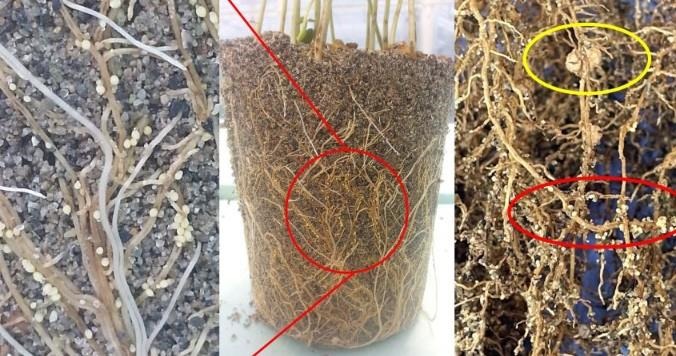By Horacio Lopez-Nicora and Greg LaBarge
Soybean cyst nematode is silently gaining territory in Ohio and SCN numbers are rising. While soybean fields infested with SCN may not show above ground symptoms or look sick, the presence of SCN females attached to soybean roots can be detected six to eight weeks after planting. We encourage Ohio soybean growers to actively manage SCN by checking roots for the presence of SCN. If you do not know if you have SCN in your field, you can dig out roots (walk your fields with a shovel and dig out plants every 30 to 50 paces), gently remove the soil without breaking the roots (a bucket with water may help separate soil from roots), and check for the presence of SCN females on the roots (Fig.1). The SCN females attached to roots are initially white to cream, turning yellow and eventually brown in color. SCN females are significantly smaller than nitrogen-fixing nodule (Fig. 1). The SCN females will eventually fill up with over 200 eggs and become the cyst that will protect and allow the eggs to survive for several years in infested fields. We encourage growers, agronomists, and crop consultants to check soybean roots for SCN throughout August and September.

Figure 1. Soybean roots infested with SCN. Note the significantly smaller lemon-shape SCN female (red circle) attached to roots compared to larger nitrogen-fixing nodules (yellow circle).
Actively managing SCN begins by knowing if you have the problem. Watch this video to learn how to check roots for the presence of SCN females. If you find out that you have SCN in your field, a soil sample in the fall will help to know your SCN numbers and define the most adequate SCN management strategies. If you already have SCN in your field and you are planting SCN resistant varieties, checking root systems for SCN can be a way to assess the performance of this management or to identify whether the SCN population in your field is adapting and reproducing on a specific source of SCN resistance (shift in virulence).
Source : osu.edu